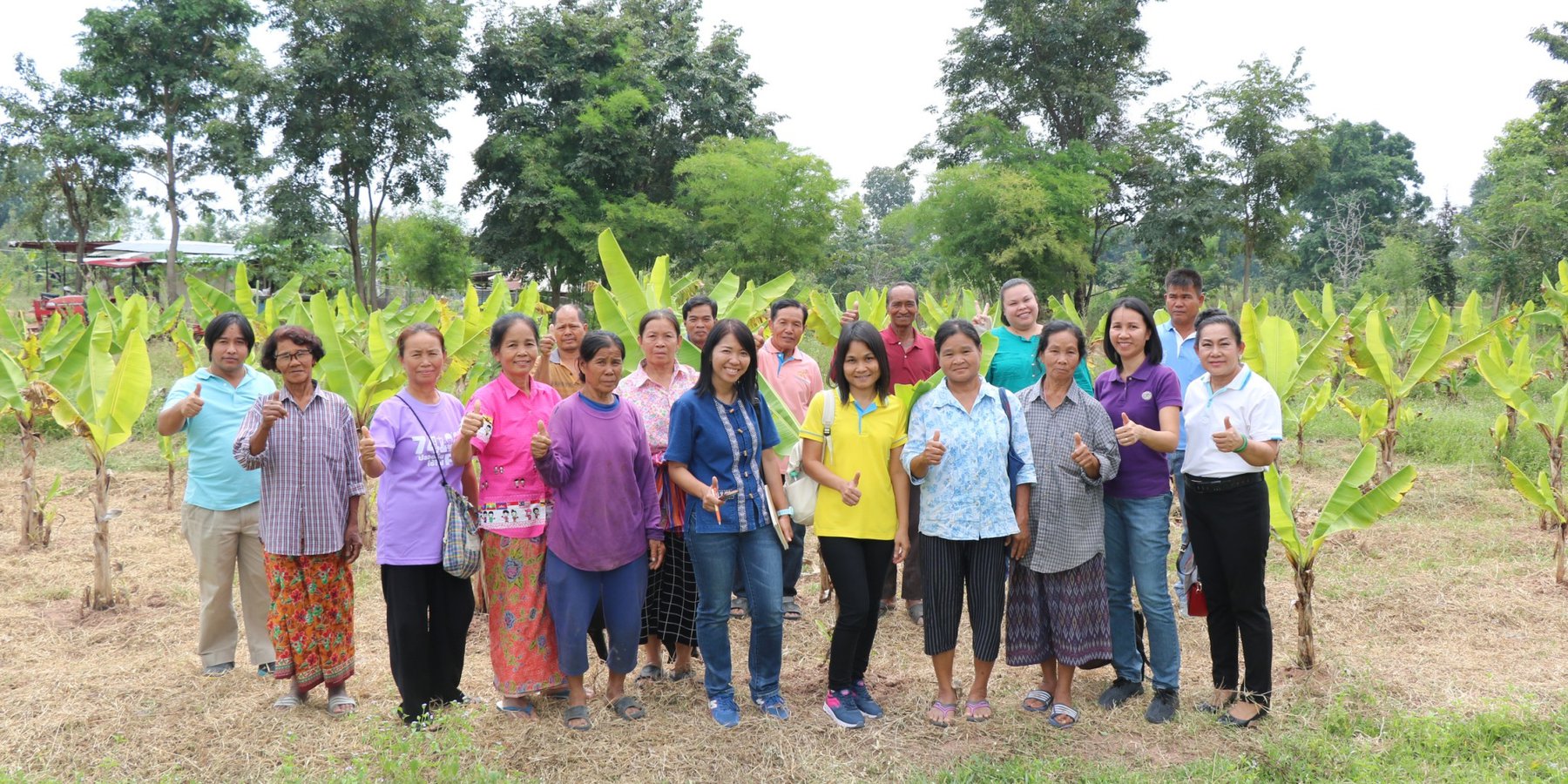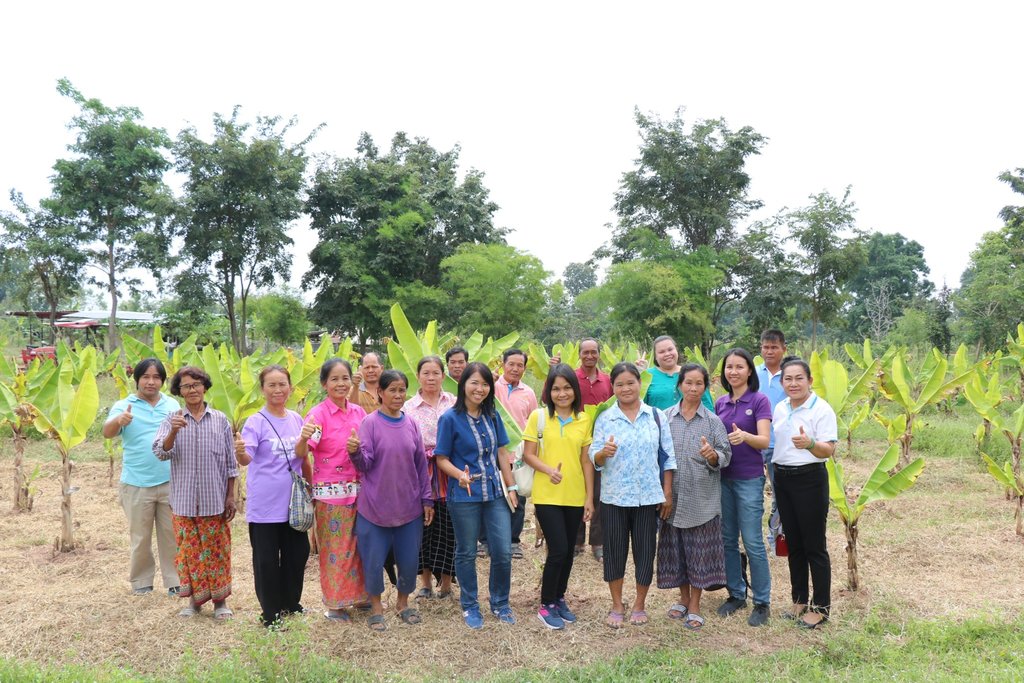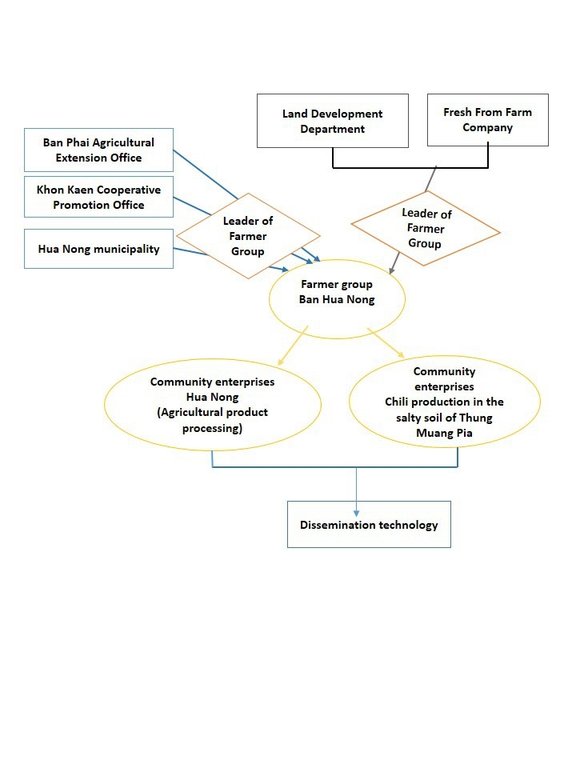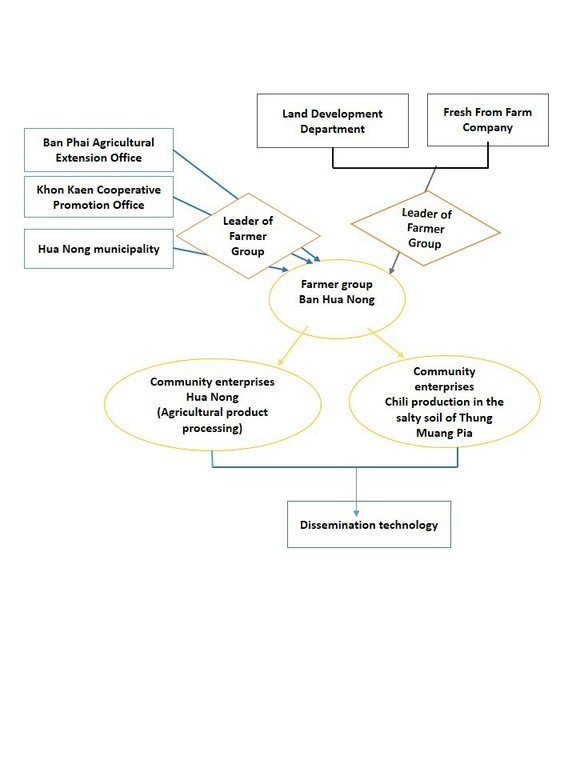Promoting the Network for Integrated Management on Salt-Affected Soils [Thailand]
- Creation:
- Update:
- Compiler: supranee sritumboon
- Editor: –
- Reviewers: Samran Sombatpanit, Rima Mekdaschi Studer, Pitayakon Limtong, William Critchley
Farmer group in saline soils
approaches_4294 - Thailand
View sections
Expand all Collapse all1. General information
1.2 Contact details of resource persons and institutions involved in the assessment and documentation of the Approach
Key resource person(s)
land user:
Sala Rabrab
Ban Hua Nong, Ban Phai, Khon Kaen, Thailand
Thailand
1.3 Conditions regarding the use of data documented through WOCAT
When were the data compiled (in the field)?
04/01/2019
The compiler and key resource person(s) accept the conditions regarding the use of data documented through WOCAT:
Yes
2. Description of the SLM Approach
2.1 Short description of the Approach
The multi-agency approach for promoting the network of integrated management on salt-affected soils has been conducted in Ban Hua Nong, Hua Nong subdistrict, Ban Phai district, Khon Kaen province since 2007. For this approach to succeed there must be a strong and selfless group leader. In addition, members of the group must have unity and share knowledge themselves and also among other groups of farmers.
2.2 Detailed description of the Approach
Detailed description of the Approach:
The multi-agency participatory approach for promoting the network of integrated management on salt-affected soils has been conducted in Ban Hua Nong, Hua Nong subdistrict, Ban Phai district, Khon Kaen province since 2007. The group of farmers was about fifteen persons – mainly women. They wanted to find a way to generate income during the post-harvest season. Because their areas are rainfed, their activities were limited to the rainy season. During the dry season, farmers lacked water and their soils are slightly salt-affected. The group needed a strong and selfless leader – and Mrs. Rabeab Sala was asked. The approach focused on exchanging opinions between farmers and agencies and developing new knowledge and capacity. There needed to be a willingness to learn. Furthermore, the members needed to have similar objectives based on the local resource. The group was supported with academic knowledge and a budget in accordance with the needs of farmers. The keys steps are as follows:
1. The integration of farmers with similar goals and concepts to develop farms of group members.
2. Selection of the group leader who is ready to sacrifice and be able to coordinate with government agencies and farmers groups from other communities.
3. Farmers group register community enterprise groups to create opportunities for access to knowledge and technology – and for marketing also.
4. Creating a platform for sharing knowledge among and between farmers, communities and agencies from government and private companies.
5. Developing training courses that improve the abilities of farmers in various aspects of their work.
6. Collaborating - government and private agencies with farmers in the community - to continuously monitor group activities to build good relations between all stakeholders resulting in more expansion if integrated management in the area.
7. Government and private agencies provide knowledge: in this case Ban Phai Agricultural Extension Office, and a budget in this case Khon Kaen Coope.
2.3 Photos of the Approach
2.5 Country/ region/ locations where the Approach has been applied
Country:
Thailand
Region/ State/ Province:
khon kaen
Further specification of location:
102.6999187………………. Latitude: 16.053112………………………
Comments:
This area has salt-affected soils and the main crop is a paddy rice under rainfed conditions
2.6 Dates of initiation and termination of the Approach
Indicate year of initiation:
2007
If precise year is not known, indicate approximate date when the Approach was initiated:
10-50 years ago
Year of termination (if Approach is no longer applied):
2018
2.7 Type of Approach
- project/ programme based
2.8 Main aims/ objectives of the Approach
This approach aims to build the capacity of farmers groups to develop agricultural areas and to process agricultural products to add value. Also, this guideline aims to secure food for family and community.
2.9 Conditions enabling or hindering implementation of the Technology/ Technologies applied under the Approach
social/ cultural/ religious norms and values
- hindering
The belief is the salt-affected soils can not improve
availability/ access to financial resources and services
- enabling
Farmer groups have more opportunities to access the financial resource
knowledge about SLM, access to technical support
- enabling
Changing and sharing the knowledge among farmers, government and private company
markets (to purchase inputs, sell products) and prices
- enabling
Diversity of the agricultural prducts
workload, availability of manpower
- enabling
Farmers are helping and supporting the work of the group
3. Participation and roles of stakeholders involved
3.1 Stakeholders involved in the Approach and their roles
- local land users/ local communities
Farmers are older than
55 years old
Perform the activities as group members.
- SLM specialists/ agricultural advisers
Expert and agriculturist
Provide knowledge and evaluate progress on-farm
- private sector
Staff of private company
Provide knowledge and evaluate on-farm
- local government
Officers of municipality
Coordinator
3.2 Involvement of local land users/ local communities in the different phases of the Approach
| Involvement of local land users/ local communities | Specify who was involved and describe activities | |
|---|---|---|
| initiation/ motivation | interactive | Farmer group shares the idea and concept for development |
| planning | interactive | Farmers and officers collaborate to design the agricultural plan |
| implementation | self-mobilization | Farmers work on farm |
| monitoring/ evaluation | interactive | Leader group collaborates with officers to evaluation the activities on farm every month |
3.3 Flow chart (if available)
Description:
The approach of promoting the integration management of salt-affected soils was used in saline soil areas to create the participation of stakeholders were included farmers in the community, government agencies, and private agencies for community development
3.4 Decision-making on the selection of SLM Technology/ Technologies
Specify who decided on the selection of the Technology/ Technologies to be implemented:
- mainly land users, supported by SLM specialists
Explain:
Farmers in the community, government agencies, and private agencies for community development
Specify on what basis decisions were made:
- evaluation of well-documented SLM knowledge (evidence-based decision-making)
- personal experience and opinions (undocumented)
4. Technical support, capacity building, and knowledge management
4.1 Capacity building/ training
Was training provided to land users/ other stakeholders?
Yes
Specify who was trained:
- land users
Form of training:
- on-the-job
- demonstration areas
Subjects covered:
The activities worked on-farm by farmer and officer
Comments:
Government provides training and demonstration
4.2 Advisory service
Do land users have access to an advisory service?
Yes
Specify whether advisory service is provided:
- on land users' fields
Describe/ comments:
Land Development Department Regional Office 5 and the farmer group had monitored and evaluated the activities of farmers in the area
4.3 Institution strengthening (organizational development)
Have institutions been established or strengthened through the Approach?
- yes, greatly
Specify the level(s) at which institutions have been strengthened or established:
- local
Describe institution, roles and responsibilities, members, etc.
Learning center
Specify type of support:
- capacity building/ training
Give further details:
Chili and banana cultivation , mushroom producing, and agricultural products processing
4.4 Monitoring and evaluation
Is monitoring and evaluation part of the Approach?
Yes
Comments:
Monitoring on farm
If yes, is this documentation intended to be used for monitoring and evaluation?
No
4.5 Research
Was research part of the Approach?
No
5. Financing and external material support
5.1 Annual budget for the SLM component of the Approach
If precise annual budget is not known, indicate range:
- 10,000-100,000
5.2 Financial/ material support provided to land users
Did land users receive financial/ material support for implementing the Technology/ Technologies?
Yes
If yes, specify type(s) of support, conditions, and provider(s):
Government had provided the knowledge to farmer group and support the equipment such as groundwater wells, tools and equipment for agricultural products processing, and rice mills, etc.
5.3 Subsidies for specific inputs (including labour)
- equipment
| Specify which inputs were subsidised | To which extent | Specify subsidies |
|---|---|---|
| machinery | fully financed | Rice mill |
| tools | fully financed | Equipment for agricultural products processing and mushroom producing |
- agricultural
| Specify which inputs were subsidised | To which extent | Specify subsidies |
|---|---|---|
| seeds | partly financed | Seeding of chili |
- construction
| Specify which inputs were subsidised | To which extent | Specify subsidies |
|---|---|---|
| wood | partly financed | Farmers provide the wood for mushroom nursery |
If labour by land users was a substantial input, was it:
- voluntary
Comments:
Working together among farmers
5.4 Credit
Was credit provided under the Approach for SLM activities?
No
5.5 Other incentives or instruments
Were other incentives or instruments used to promote implementation of SLM Technologies?
Yes
If yes, specify:
Promotion through the media
6. Impact analysis and concluding statements
6.1 Impacts of the Approach
Did the Approach empower local land users, improve stakeholder participation?
- No
- Yes, little
- Yes, moderately
- Yes, greatly
Strong group
Did the Approach help land users to implement and maintain SLM Technologies?
- No
- Yes, little
- Yes, moderately
- Yes, greatly
Distribute to the other community
Did the Approach mobilize/ improve access to financial resources for SLM implementation?
- No
- Yes, little
- Yes, moderately
- Yes, greatly
Create the confidence for the financial resource
Did the Approach improve knowledge and capacities of land users to implement SLM?
- No
- Yes, little
- Yes, moderately
- Yes, greatly
Learning center
Did the Approach build/ strengthen institutions, collaboration between stakeholders?
- No
- Yes, little
- Yes, moderately
- Yes, greatly
Having a forum for discussion and sharing the idea
Did the Approach encourage young people/ the next generation of land users to engage in SLM?
- No
- Yes, little
- Yes, moderately
- Yes, greatly
Encourage the young farmer
Did the Approach lead to improved food security/ improved nutrition?
- No
- Yes, little
- Yes, moderately
- Yes, greatly
Food security and increase income
Did the Approach improve access to markets?
- No
- Yes, little
- Yes, moderately
- Yes, greatly
Community market
Did the Approach improve the capacity of the land users to adapt to climate changes/ extremes and mitigate climate related disasters?
- No
- Yes, little
- Yes, moderately
- Yes, greatly
Mix cropping system
Did the Approach lead to employment, income opportunities?
- No
- Yes, little
- Yes, moderately
- Yes, greatly
Mix cropping system
6.2 Main motivation of land users to implement SLM
- increased production
diversity of food crop
- increased profit(ability), improved cost-benefit-ratio
increasing income
- reduced land degradation
more soil improvement by adding organic matter
- reduced risk of disasters
shallow groundwater well
- enhanced SLM knowledge and skills
changing and sharing the knowledge
6.3 Sustainability of Approach activities
Can the land users sustain what has been implemented through the Approach (without external support)?
- yes
If yes, describe how:
diversity of agricultural activities and create the food security
6.4 Strengths/ advantages of the Approach
| Strengths/ advantages/ opportunities in the land user’s view |
|---|
|
1.This approach provided the opportunities for farmers to access knowledge and technologies that according to themselves. 2.Farmers could share the knowledge among farmers and government agencies and private agencies. 3. Farmer has been further developed based on the knowledge and experience of themselves. 4.This approach leads community to develop sustainable production and food security on their land. |
| Strengths/ advantages/ opportunities in the compiler’s or other key resource person’s view |
|---|
| Changing and sharing the knowledge |
6.5 Weaknesses/ disadvantages of the Approach and ways of overcoming them
| Weaknesses/ disadvantages/ risks in the land user’s view | How can they be overcome? |
|---|---|
| The shallow groundwater is not enough for farmers | Government support |
| The belief that a saline soil could not be improved | Study from the success area |
| Weaknesses/ disadvantages/ risks in the compiler’s or other key resource person’s view | How can they be overcome? |
|---|---|
| A strong group leader is the important factor for achieving success |
7. References and links
7.1 Methods/ sources of information
- field visits, field surveys
2 sites
- interviews with land users
6 persons
- interviews with SLM specialists/ experts
1 persons
Links and modules
Expand all Collapse allLinks
No links
Modules
No modules





